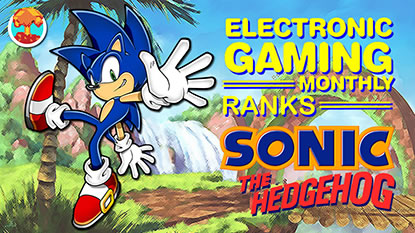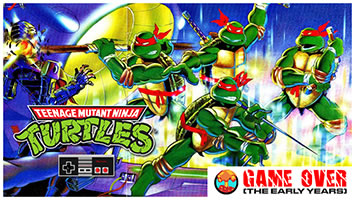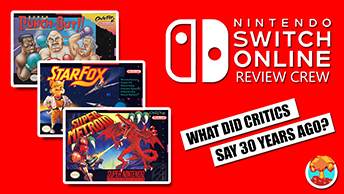- CLASSIC MAGAZINES
- REVIEW CREW
A show recapping what critics thought back
when classic games first came out! - NEXT GENERATION'S BEST & WORST
From the worst 1-star reviews to the best
5-stars can offer, this is Next Generation! - NINTENDO POWER (ARCHIVE)
Experience a variety of shows looking at the
often baffling history of Nintendo Power! - MAGAZINE RETROSPECTIVE
We're looking at the absolutely true history of
some of the most iconic game magazines ever! - SUPER PLAY'S TOP 600
The longest and most ambitious Super NES
countdown on the internet! - THEY SAID WHAT?
Debunking predictions and gossip found
in classic video game magazines! - NEXT GENERATION UNCOVERED
Cyril is back in this spin-off series, featuring the
cover critic review the art of Next Generation! - HARDCORE GAMER MAGAZING (PDF ISSUES)
Download all 36 issues of Hardcore Gamer
Magazine and relive the fun in PDF form!
- REVIEW CREW
- ELECTRONIC GAMING MONTHLY
- ELECTRONIC GAMING MONTHLY RANKS
From Mario to Sonic to Street Fighter, EGM
ranks classic game franchises and consoles! - ELECTRONIC GAMING MONTHLY BEST & WORST
Counting down EGM’s best and worst reviews
going year by year, from 1989 – 2009! - ELECTRONIC GAMING BEST & WORST AWARDS
11-part video series chronicling the ups and
downs of EGM’s Best & Worst Awards!
- ELECTRONIC GAMING MONTHLY RANKS
- GAME HISTORY
- GAME OVER: STORY BREAKDOWNS
Long-running series breaking down game
stories and analyzing their endings! - A BRIEF HISTORY OF GAMING w/ [NAME HERE]
Real history presented in a fun and pithy
format from a variety of game historians! - THE BLACK SHEEP
A series looking back at the black sheep
entries in popular game franchises! - INSTANT EXPERT
Everything you could possibly want to know
about a wide variety of gaming topics! - FREEZE FRAME
When something familiar happens in the games
industry, we're there to take a picture! - I'VE GOT YOUR NUMBER
Learn real video game history through a series
of number-themed episodes, starting at zero! - GREAT MOMENTS IN BAD ACTING
A joyous celebration of some of gaming's
absolute worst voice acting!
- GAME OVER: STORY BREAKDOWNS
- POPULAR SHOWS
- DG NEWS w/ LORNE RISELEY
Newsman Lorne Riseley hosts a regular
series looking at the hottest gaming news! - REVIEW REWIND
Cyril replays a game he reviewed 10+ years
ago to see if he got it right or wrong! - ON-RUNNING FEUDS
Defunct Games' longest-running show, with
editorials, observations and other fun oddities! - DEFUNCT GAMES QUIZ (ARCHIVE)
From online quizzes to game shows, we're
putting your video game knowledge to the test!- QUIZ: ONLINE PASS
Take a weekly quiz to see how well you know
the news and current gaming events! - QUIZ: KNOW THE GAME
One-on-one quiz show where contestants
find out if they actually know classic games! - QUIZ: THE LEADERBOARD
Can you guess the game based on the classic
review? Find out with The Leaderboard!
- QUIZ: ONLINE PASS
- DEFUNCT GAMES VS.
Cyril and the Defunct Games staff isn't afraid
to choose their favorite games and more! - CYRIL READS WORLDS OF POWER
Defunct Games recreates classic game
novelizations through the audio book format!
- DG NEWS w/ LORNE RISELEY
- COMEDY
- GAME EXPECTANCY
How long will your favorite hero live? We crunch
the numbers in this series about dying! - VIDEO GAME ADVICE
Famous game characters answer real personal
advice questions with a humorous slant! - FAKE GAMES: GUERILLA SCRAPBOOK
A long-running series about fake games and
the people who love them (covers included)! - WORST GAME EVER
A contest that attempts to create the worst
video game ever made, complete with covers! - LEVEL 1 STORIES
Literature based on the first stages of some
of your favorite classic video games! - THE COVER CRITIC
One of Defunct Games' earliest shows, Cover
Critic digs up some of the worst box art ever! - COMMERCIAL BREAK
Take a trip through some of the best and
worst video game advertisements of all time! - COMIC BOOK MODS
You've never seen comics like this before.
A curious mix of rewritten video game comics!
- GAME EXPECTANCY
- SERIES ARCHIVE
- NINTENDO SWITCH ONLINE ARCHIVE
A regularly-updated list of every Nintendo
Switch Online release, plus links to review! - PLAYSTATION PLUS CLASSIC ARCHIVE
A comprehensive list of every PlayStation
Plus classic release, including links! - RETRO-BIT PUBLISHING ARCHIVE
A regularly-updated list of every Retro-Bit
game released! - REVIEW MARATHONS w/ ADAM WALLACE
Join critic Adam Wallace as he takes us on a
classic review marathon with different themes!- DEFUNCT GAMES GOLF CLUB
Adam Wallace takes to the links to slice his way
through 72 classic golf game reviews! - 007 IN PIXELS
Adam Wallace takes on the world's greatest spy
as he reviews 15 weeks of James Bond games! - A SALUTE TO VAMPIRES
Adam Wallace is sinking his teeth into a series
covering Castlevania, BloodRayne and more! - CAPCOM'S CURSE
Adam Wallace is celebrating 13 days of Halloween
with a line-up of Capcom's scariest games! - THE FALL OF SUPERMAN
Adam Wallace is a man of steel for playing
some of the absolute worst Superman games! - THE 31 GAMES OF HALLOWEEN
Adam Wallace spends every day of October afraid
as he reviews some of the scariest games ever! - 12 WEEKS OF STAR TREK
Adam Wallace boldly goes where no critic has
gone before in this Star Trek marathon!
- DEFUNCT GAMES GOLF CLUB
- DAYS OF CHRISTMAS (ARCHIVE)
Annual holiday series with themed-episodes
that date all the way back to 2001!- 2015: 30 Ridiculous Retro Rumors
- 2014: 29 Magazines of Christmas
- 2013: 29 Questionable Power-Ups of Christmas
- 2012: 34 Theme Songs of Christmas
- 2011: 32 Game Endings of Christmas
- 2010: 31 Bonus Levels of Christmas
- 2009: 30 Genres of Christmas
- 2008: 29 Controls of Christmas
- 2007: 34 Cliches of Christmas
- 2006: 33 Consoles of Christmas
- 2005: 32 Articles of Christmas
- 2004: 31 Websites of Christmas
- 2003: 29 Issues of Christmas
- 2002: 28 Years of Christmas
- 2001: 33 Days of Christmas
- NINTENDO SWITCH ONLINE ARCHIVE
- REVIEW ARCHIVE
- FULL ARCHIVE
To Boldly Go: 12 Weeks of Star Trek
Space: The final frontier. This is the journey of Adam Wallace. His twelve week mission: To explore strange new worlds, to seek out new life and new civilizations and to boldly go where no man has gone before in a wide variety of different Star Trek games. Beam up to a brand new Roddenberry-inspired review every Wednesday between July 5 and September 20. That's one new review every week leading up to the debut of Star Trek: Discovery starring Michelle Yeoh and Rainn Wilson. Resistance is futile!
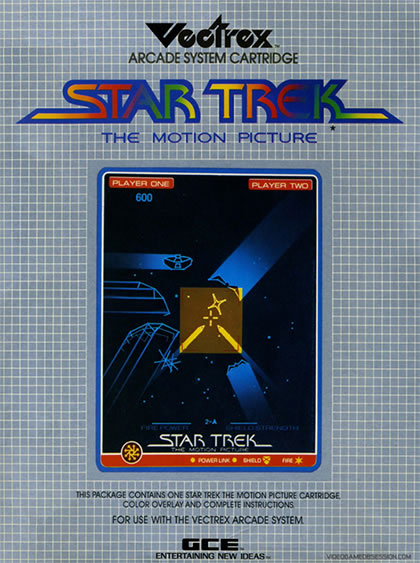
Some movie licenses are just baffling. Why go to the trouble of getting the license to a movie just to apply it to a game that has almost nothing to do with it? To be fair, I'm sure that even the most die-hard Trekker wouldn't want a game that's truly based on the first Star Trek film, often called "The Slow Motion Picture" or "The Motion-Less Picture" for good reason. Although I am more forgiving of TMP than many people, I do acknowledge that there is NOTHING in the film that could make for a compelling game, especially in the early 80's when games had to stay simple due to technological limitations. Fortunately, GCE didn't try to force their Vectrex game to try to match the movie, making the game the better of the two. [READ FULL REVIEW]
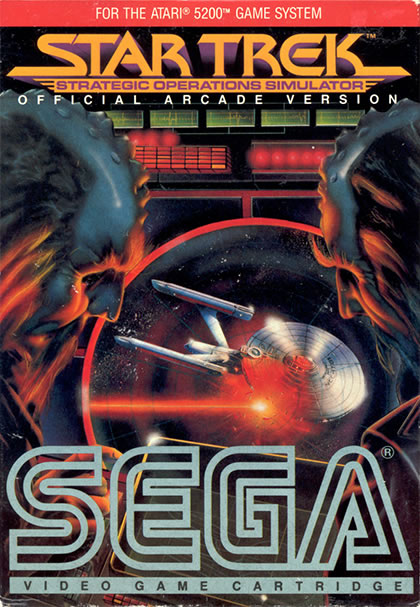
I remember a lot of buzz in 2001 about how Sega was abandoning the Dreamcast and reverting to a third-party publisher. While it was surprising for many people who were gamers during the Genesis vs. Super Nintendo era, older gamers like me remember that Sega was a third-party publisher in the early 80's before the release of the Sega Master System. Sega games had a presence on the Atari consoles, the Intellivision, and the Colecovision, mostly with their arcade ports. In fact, they released a Star Trek arcade game just in time to capitalize on the theatrical release of Star Trek 2: The Wrath of Khan, one of the greatest movies of all time (and much more fitting for a game than the first film). That game got ported to the second gen consoles as Star Trek: Strategic Operations Simulator, and the Atari 5200 version was a strong console port of an average arcade game. [READ FULL REVIEW]
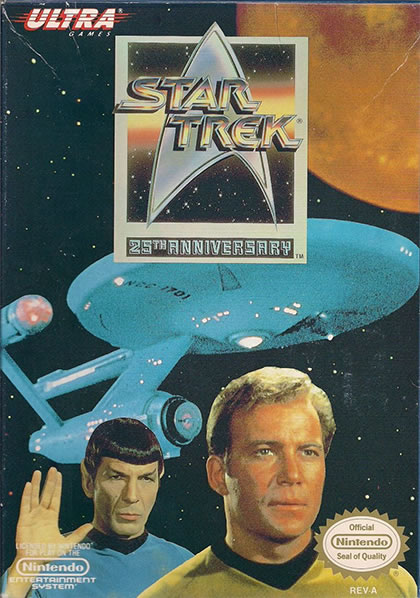
The 25th anniversary of the original Star Trek series was treated as a special event back in 1991. I distinctly remember even seeing a prime-time TV special about it. Naturally, it was the perfect time to release a Nintendo game. Instead of making a game based on the movie that hit theaters at that time Star Trek 6: The Undiscovered Country, Interplay decided to make a game honoring the original series. They had plenty of good ideas. It's just a shame the execution of those ideas was a mess.
The plot of the game involves a rip in space that sends the Enterprise out of control into uncharted territory. Kirk and the crew need to find their way back to Federation territory and seal the rip. [READ FULL REVIEW]
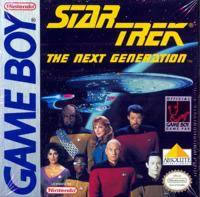
Commanding a starship involves a lot more than just pointing the weapons in the right direction. That was the tack a lot of Star Trek games adopted in the 90's. As a clear counter to the Star Wars games where every problem is solved with a blaster or a lightsaber, Star Trek games tried to include the exploration, diplomacy, and navigation that was present in the shows along with the phaser battles. While a neat idea, it didn't translate well all the time. Star Trek: The Next Generation for the Game Boy was a prime example of how that idea can go wrong. [READ FULL REVIEW]
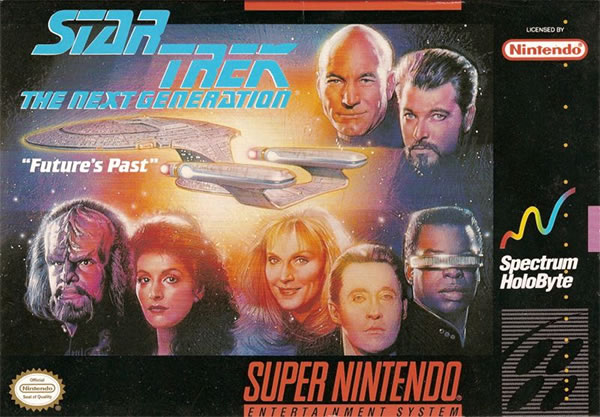
I was pretty harsh on the Star Trek: The Next Generation game on the Game Boy. It's just that I saw what the developers were trying to do, provide an experience equal to the TV show, but incompetence on the fundamentals ruined it. I think now maybe the developers just bit off more than they could chew. There was only so much that could be done with a monochrome screen, eight bits, and two action buttons. Surely the far more powerful and versatile Super Nintendo could deliver the true Next Generation experience, right? Not if Future's End is any indication. [READ FULL REVIEW]
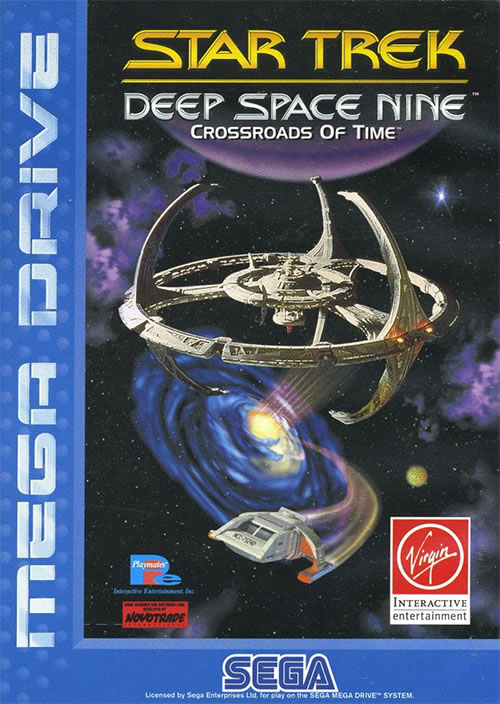
Deep Space Nine is my personal favorite among the Star Trek spin-off TV shows. The characters were more complex than in the other shows, and the storylines were the most involved. At least, that's how they were by the last couple of seasons. The first season of the show wasn't bad by any means, but it was uninspired. There was only so much mileage the show can get from a new alien coming through the Wormhole or Gul Dukat being a local jackass. I really wish that game designers held off on making DS9 games until the start of the Dominion War which would've been an absolute goldmine of possibilities for amazing games. Instead, console owners got Crossroads of Time, a game as uninspired as the first season it's set in. [READ FULL REVIEW]
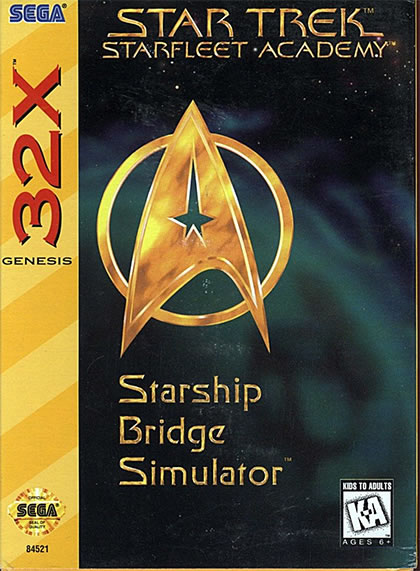
Bridge simulators had proven to be quite tough to get right on consoles. It would almost make me worry about the bridge simulators that are in development for the VR headsets. However, I have found a bridge simulator that, while nowhere near perfect, did get enough right to give me hope. Even more amazingly, that simulator was on the much-maligned Sega 32X.
Star Trek: Starfleet Academy - Starship Bridge Simulator (man, think the name is long enough?) takes place during the era of the second through sixth Star Trek films. Like with the Next Generation game on Game Boy, there's no overarching story or anything like that. You play a cadet going through bridge command training; that's it. [READ FULL REVIEW]
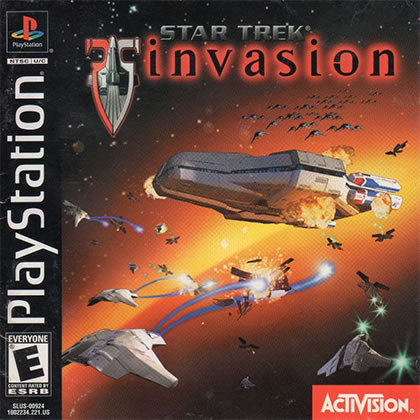
I say the following sentence as a life-long Star Trek fan. Trekkers need to loosen up! It seems like anytime something pops up that seems counter to creator Gene Roddenberry's ideas for the franchise, the die-hard fans cry, "Betrayal!" They certainly screamed plenty when Star Trek: Invasion hit the Playstation back in 2000. No, it's not something that would fit in with Gene's ideas, but it's still a great game.
While the existence of Federation starfighters drew the ire of die-hard fans, the plot does fit in with the franchise as far as I'm concerned. [READ FULL REVIEW]
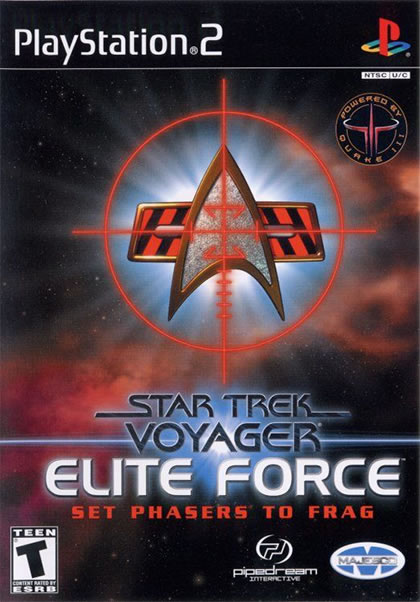
As much of a Star Trek fan as I am, I was very late getting into the fourth live-action series in the franchise Star Trek: Voyager. The first few episodes turned me off due to the lameness of Neelix, the obnoxiousness of Tom Paris, and the abrasiveness of Captain Janeway. Only recently did I give the show another chance, and it did get much better after the first season. The game Star Trek: Voyager - Elite Force feels like an authentic extension of the show, but I wish I could say it was an excellent Playstation 2 game.
The premise for the game is a perfect fit for the show. Since the starship Voyager was thrown 70,000 light years from the Federation, they had to fend for themselves while heading home. [READ FULL REVIEW]
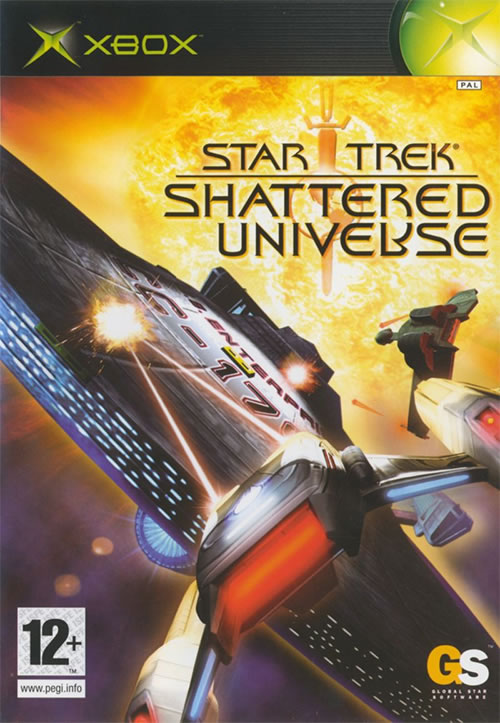
"Mirror, Mirror" was one of the greatest episodes in the entire Star Trek franchise. The idea of a parallel dimension where everything was the opposite of the familiar struck a chord with sci-fi fans. The idea worked so well that the mirror universe was revisited in later Star Trek shows, even providing one of the only watchable episodes of Enterprise. Considering the conniptions die-hard fans got into over Star Trek: Invasion, a space dogfighter set in the mirror universe would seem like the perfect concept to appeal to both Trekkers and gamers. Unfortunately, Star Trek: Shattered Universe shows how a can't-miss idea can still be botched.
The game takes place after the events of Star Trek 6. Capt. Sulu of the Excelsior goes through an ion storm and ends up in the mirror universe. [READ FULL REVIEW]
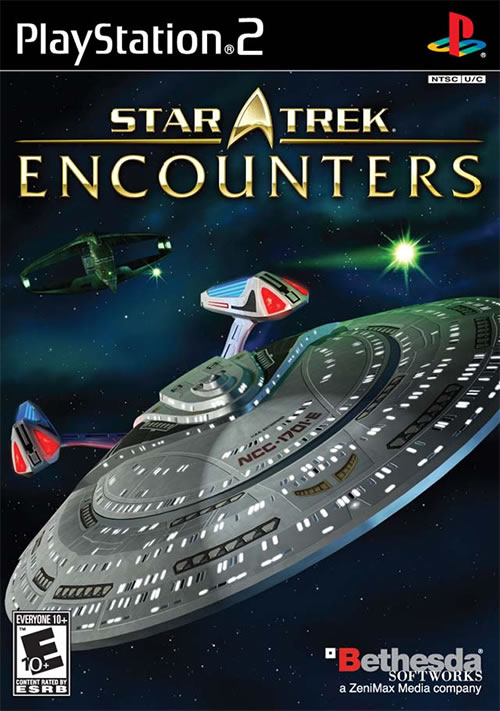
2006 marked the 40th Anniversary of Star Trek. It was also the time when the 6th console generation was transitioning to the 7th. As such, two very different games were released to honor the history of the franchise. Star Trek: Legacy got the lion's share of the attention for two major reasons. The first is that it was releasing on the then-brand-new Xbox 360. The second is that it was much better than Star Trek: Encounters on the Playstation 2.
Like Legacy, Encounters features ships and scenarios from the entire history of the franchise. Unlike Legacy, there is no overarching plot to connect the different series. Each series gets a two to four mission arc to itself, from Capt. Archer's battle with the Xindi to searching for missing ships during the Dominion War. [READ FULL REVIEW]
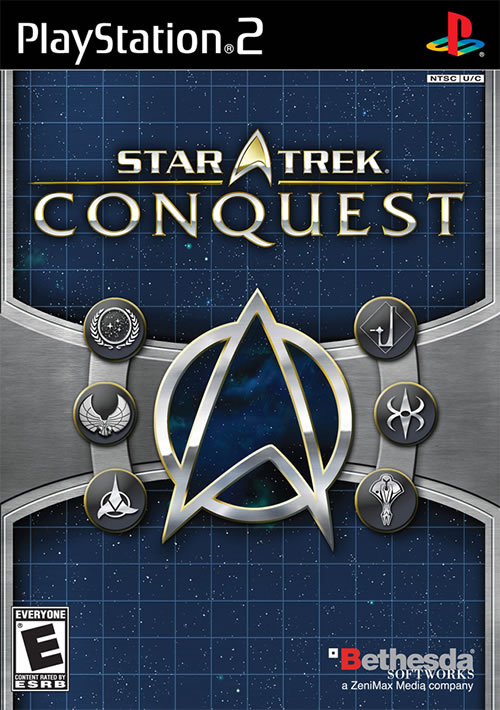
Some TV and film franchises are limited in what can be done in video games. For example, The Matrix is pretty much stuck providing action games since it can't work in other game genres without forcing it big-time. Star Trek doesn't have that handicap. The wealth of set-ups and stories in the franchise allow for it to fit in almost any genre. This makes it weird that it took until 2007 for the franchise to enter strategy territory. Fortunately, Star Trek: Conquest was a decent trip into that unknown area as long as you can ignore a few hull breaches.
Like most of the Star Trek games I covered, there is a set-up but no plot. The campaign mode is all about taking one of six races (Human, Klingon, Romulan, Breen, Cardassians, and Dominion) and conquering the other races with them. [READ FULL REVIEW]
HOME |
CONTACT |
NOW HIRING |
WHAT IS DEFUNCT GAMES? |
NINTENDO SWITCH ONLINE |
RETRO-BIT PUBLISHING
Retro-Bit |
Switch Planet |
The Halcyon Show |
Same Name, Different Game |
Dragnix |
Press the Buttons
Game Zone Online | Hardcore Gamer | The Dreamcast Junkyard | Video Game Blogger
Dr Strife | Games For Lunch | Mondo Cool Cast | Boxed Pixels | Sega CD Universe | Gaming Trend
Game Zone Online | Hardcore Gamer | The Dreamcast Junkyard | Video Game Blogger
Dr Strife | Games For Lunch | Mondo Cool Cast | Boxed Pixels | Sega CD Universe | Gaming Trend
Copyright © 2001-2025 Defunct Games
All rights reserved. All trademarks are properties of their respective owners.
All rights reserved. All trademarks are properties of their respective owners.

























